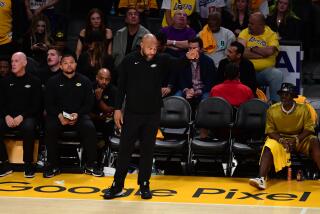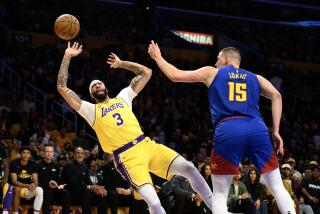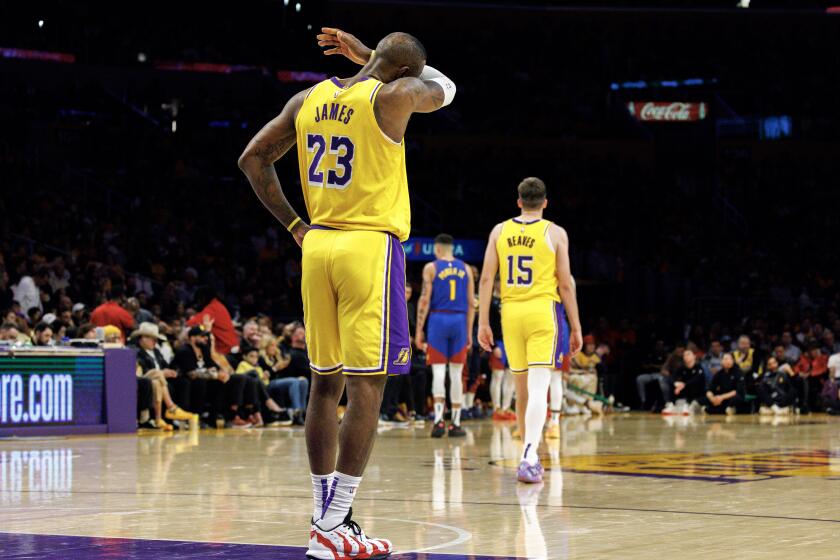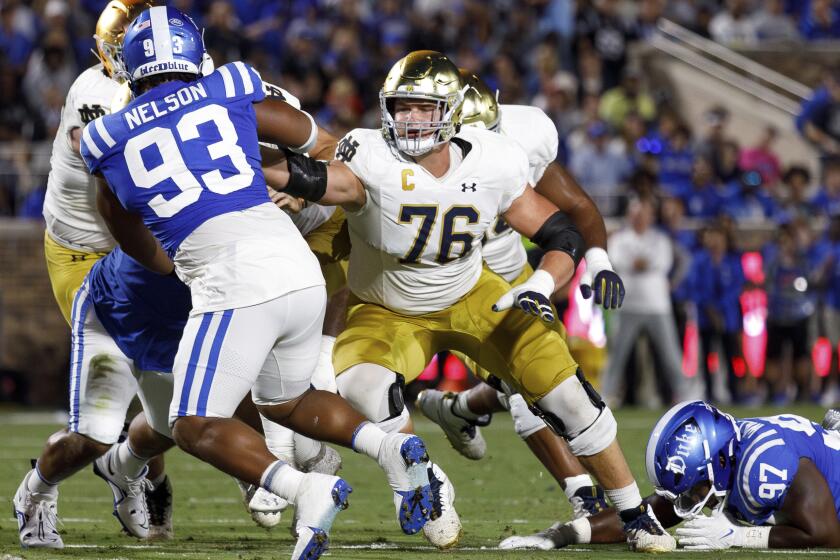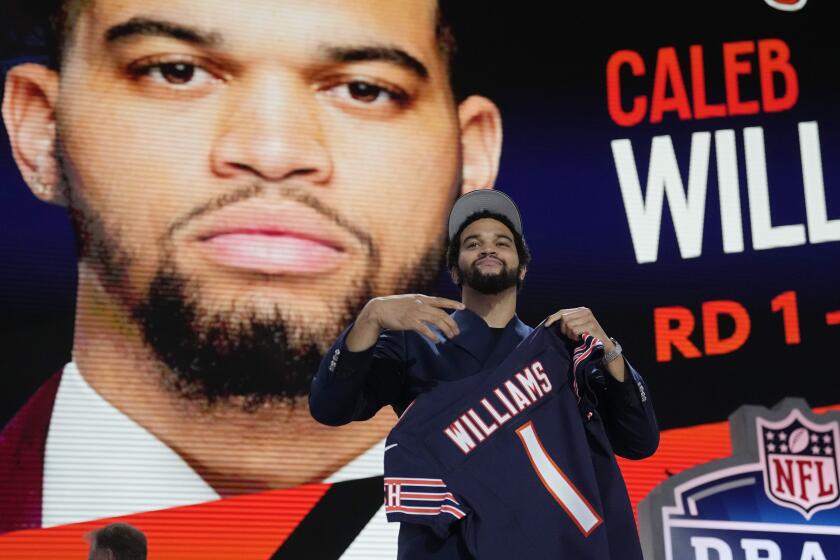Del Rio Time
Jack Del Rio, a 1981-84 USC linebacker who started for the Trojans all four years, will get the next chance to stop Peyton Manning, the Indianapolis quarterback who threw the ball on every snap in the first quarter of last Sunday’s 43-31 win over Green Bay. In that victory, the Colts became the only NFL team to total 100 points in the first three weeks of the new season.
Del Rio was a defensive expert at USC and a consensus All-American. At Jacksonville, he coaches the 3-0 Jaguars, whose defense has given up a total of 28 points — a league-leading weekly average of 9.3 — in the same month that 2-1 Indianapolis has been scoring a league-leading average 33.3.
At the moment, Jacksonville and Indianapolis are 1-2 in the AFC South after the Jaguars upset Tennessee last Sunday, 15-12. And when they meet the Colts in Jacksonville next Sunday, Manning will see one of the least experienced head coaches in football. After 11 seasons as an NFL linebacker, Del Rio, 41, had been an NFL assistant for only six years before Jacksonville owner Wayne Weaver brought him in as Tom Coughlin’s successor on Jan. 17, 2003.
Immature? Sure. Inobservant? No way. In Del Rio’s rookie season, the Jaguars, setting up the 2004 season, finished 5-11 with a rookie quarterback, Byron Leftwich. And you haven’t heard the last of Leftwich. Or Del Rio.
How Parcells Won a Passing Duel
Long, long ago, Bill Parcells of the Dallas Cowboys and Joe Gibbs of the Washington Redskins were both devoted running-play coaches who, if they felt frisky enough, might pass on third down — sometimes. Or might not. But those days are long gone.
NFL rules and attitudes and styles have changed since Parcells and Gibbs were boys. Theirs is a passing league now. And in a new-fangled passing duel, the two 63-year-old leaders sent their new quarterbacks out throwing Monday night, Vinny Testaverde for Dallas, Mark Brunell for the Redskins.
It’s the new NFL game they were playing. In any case, Gibbs was trying to play it — much of the time. He even tried three-wide receiver formations briefly.
But though Parcells and Gibbs both spent years in exile from football, Parcells had come back a year or two earlier and has played modern football longer.
Thus, Parcells’ team led all the way — and won it, 21-18 — as Testaverde put the Dallas players through the more sophisticated pass offense with the better-designed pass plays. It was the Cowboys who understood how to unleash long passes until they drew a marginal interference penalty setting up an easy touchdown. It was the Cowboys who in the third quarter covered 80 yards with three consecutive downfield passes for another touchdown. It was the Cowboys who threw the halfback pass for the winning touchdown.
But Gibbs tried. He was ready with a timely two-point conversion pass. And in one memorable second-quarter bit, Gibbs and Brunell stitched together a 15-play drive from their 9 to the Cowboys’ 1, mostly on consecutive passes. On the goal line, unhappily, Gibbs reverted to his old-time running game and had to kick a field goal. And for too much of the fourth quarter, Gibbs was still running Clinton Portis. Otherwise, often, Gibbs was trying. He’ll get it. And that’s encouraging.
Manning Throws on Every Down
The Colts against Green Bay came up with a new meaning for the old maxim to “come out throwing.” With powerful runner Edgerrin James in good health, they never used him or anyone else as a ballcarrier in the first quarter, when, instead, Manning passed for 270 yards and three of his five touchdowns.
Even though the Packers had some problem areas in their defense along with faulty planning — they came out to stop James rather than Manning — the Colts’ air show was well conceived and beautifully done.
It illustrated what can be accomplished by NFL players who throw exclusively when they have a good passer and three good little receivers. The Indianapolis starters, Marvin Harrison and Reggie Wayne, both stand (at most) 6 feet even. And third receiver Brandon Stokley rises only 5 feet 11.
The Colts in the Manning era have until now been beaten themselves by running James, good as he is, instead of airing out the ball with their extraordinary passer. Chances are, they could have reached at least one Super Bowl under either of their last two leaders, Jim Mora and Tony Dungy, if, in every previous game, they hadn’t attempted to, as Dungy says, “establish the run.” That strategy has in effect handcuffed Manning, who too often has been asked to throw his first pass of any series on third and long.
Strategically, one problem with hammering a defense with a good running back is that it takes too long for runners to score. A passer can score on one play. When the officials are enforcing the rules, a good passer working with a sound offensive coordinator can move the ball against any defense.
Packers Run Themselves Out of the Game
The Packers, in the Indianapolis game, became the latest good offensive team to lose by repeatedly running the ball on first down. Their quarterback, Brett Favre, matched Manning touchdown for touchdown for a while and finished with four scoring passes, in spite of which, dedicating their offense to a good running back, Ahman Green, the Packers attempted to run him on nearly every series before calling on Favre to throw.
The recent chatter out of Green Bay is that the Packers have decided to be a running team this season because their passer was born in 1969, some 35 years ago. That perception, however, has never been accurate. For years, the Packers have been the NFL’s best-integrated offensive team — meaning the way they intersperse passes with runs. They’ve won by threatening with Favre and Green on almost every play and then dividing up their chores.
Nonetheless, Indianapolis’ defensive people believed the word they heard from Green Bay and lined up to stop Green, who ironically, and unwisely, was asked routinely to run on first down against an 8-3 defense. Naturally, he couldn’t run far.
Their strategy finally beat the Packers — in the second quarter — when on successive first-down runs the Colts kept denying Green at the line of scrimmage and Favre couldn’t quite make up the difference thereafter. The other quarterback, Manning, passing on all but four plays in the first half, stepped away to a 35-17 lead at the intermission.
One problem with running and failing on first down is that it asks the quarterback to pass for 10 yards on the next two downs — against defenses now aligned to prevent pass completions. It reduces offensive football from a three-down game to a two-down game. The success percentage also drops by that margin, as the Packers, no doubt, could tell you now.
How Davis, 178, KOs Walker, 220
The decisive play at Indianapolis was a highlight of the fourth quarter after the Packers had changed to anti-Manning defenses, prompting the Indianapolis coaches to cease passing and reinstitute their usual running-play offense with James. This had a predictable result: The Packers crept back into the game, which, suddenly, the Colts led by only a touchdown, 38-31.
At that juncture, a Colt rookie, cornerback Jason David of Washington State, proved once more that turnovers are not all alike. Making the only big defensive play of a strange game, David stripped the ball from a Green Bay receiver, Javon Walker, who at 6-3 and 220 pounds is not only much taller and bigger than the 5-8, 170-pound David, but stronger.
Strength, however, is relative. Walker had to hold a ball. David only had to hold Walker’s arm and tug away and wait until he could grip him with the other arm and rip the ball out. It was David’s patient waiting that finally beat Walker.
There is an important factor of luck to most fumbles. This one, though, was earned — an earned turnover instead of a fumble. At the Green Bay 38, it ended a Packer drive toward what could have been the tying touchdown and set up Manning for his fifth touchdown on a 34-yard pass.
Were the Colts the better team? Only when they were throwing the ball.
Best Rams Mess Up Big Time
The St. Louis Rams, during their championship-years heyday at the turn of the century, were never the most disciplined team in football. But they used to overcome their lack of discipline with brilliant pass plays. They can’t do that now. They aren’t that good.
Sloppy, unnecessary mistakes by their finest players cost the Rams last Sunday.
Their best passer (Marc Bulger), their best blocker (Orlando Pace), their best receiver (Isaac Bruce) and their best defensive back (Aeneas Williams) all messed up big-time to make it possible for the New Orleans Saints to sail in, 28-25.
Bulger fumbled the ball away in the first quarter to terminate the momentum he had earned with an all-pass 66-yard drive to the game’s 7-0 touchdown. On the fumble play, Bulger, when he couldn’t get a pass off, had fought his way back to the line of scrimmage — as coached. But he hadn’t been properly coached to protect the ball when heavily rushed. Either that or he forgot, and either way it was an inexcusable fumble.
Pace kept jumping offside, also inexcusable in an All-Pro blocker. His problem was that, time-wise, he’s still in training camp, having missed the whole preseason in a salary fight with management. West Coast Ram fans don’t need to hear the details to know that for the monetary rhubarb, management must have been mostly at fault.
Bruce dropped an easy pass at a strategic moment and Williams dropped an easy interception on an even more important play — quarterback Aaron Brooks’ pass for New Orleans’ go-ahead touchdown in the fourth quarter. When Williams ran directly into the errant ball, looked it over, and dropped it, Joe Horn, the wide receiver for whom it was intended, said thanks and caught it. All that adds up to a sufficient reason why the Rams aren’t winning.
Buc Earns Big Fine, Raiders Find Vertical Star
The Tampa Bay Buccaneers, losing a 30-20 game at Oakland Sunday night, didn’t put up much of a fight. But they did make one $50,000 play. That’s what Tampa linebacker Derrick Brooks should be fined — at least — for the illegal hit that broke Raider quarterback Rich Gannon’s neck and ended his season if not his career. Gannon is 38.
Brooks, who danced merrily over the stricken quarterback after the first-quarter foul, had made a particularly vicious assault.
Playing by the rules, Gannon, who led Oakland to the 2003 Super Bowl, had already given himself up after a scramble. He was sliding along the ground feet first when Brooks came flying at him, attacking Gannon with his helmeted head. Technically, it’s helmet-to-helmet hitting. Actually, it’s a lot worse than it sounds. Surely, it will earn the biggest fine of the NFL season.
The aftermath was as strange as things usually are with the Raiders. When Gannon went down, they found a classic Raider quarterback, a big-armed natural for the vertical passing attack that owner Al Davis always talks about. He is Kerry Collins, 6 feet 5, 245 pounds, the second-largest quarterback in captivity.
A larger version of Daryle Lamonica, Jim Plunkett and other vertical stars of other Raider seasons, Collins isn’t as gifted as, for instance, Plunkett, who remains the most underrated great quarterback of all time after winning two Super Bowls for the Raiders. But Collins is a satisfactory passer. And in Oakland, unlike New York, where he came from this year, the Raiders’ new Mr. Vertical will have plenty of help. There might not be a better wide receiver in football than their man Jerry Porter. And Tyrone Wheatley is an adequate running back. Conceivably, the good times are rolling again at Oakland.
More to Read
Get our high school sports newsletter
Prep Rally is devoted to the SoCal high school sports experience, bringing you scores, stories and a behind-the-scenes look at what makes prep sports so popular.
You may occasionally receive promotional content from the Los Angeles Times.
